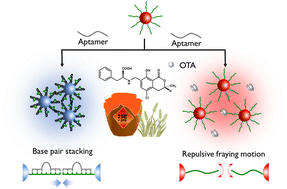Suppressed DNA base pair stacking assembly of gold nanoparticles in an alcoholic solvent for enhanced ochratoxin A detection in Baijiu†
Abstract
The currently established DNA nanoprobes for the detection of mycotoxin from beverages have been limited by complicated sample pretreatment and uncontrollable nanoparticle flocculation in complex systems. We develop a rapid colorimetric approach for ochratoxin A (OTA) detection in Baijiu in a sample-in/“yes” or “no” answer-out fashion through target-modulated base pair stacking assembly of DNA-functionalized gold nanoparticles (DNA–AuNPs). The colorimetric signification of OTA relies on the competition of OTA with the AuNP surface-grafted DNA in binding with an OTA-targeted aptamer. The specific recognition of OTA by the aptamer prevents DNA duplex formation on the AuNP surface, thereby inhibiting the base pair stacking assembly of the DNA–AuNPs and giving rise to a “turn-on” color. By further suppressing DNA hybridization using a bulged loop design and an alcohol solution, the DNA–AuNPs exhibit an improved reproducibility for OTA sensing while maintaining excellent susceptivity to OTA. A detection limit of 88 nM was achieved along with high specificity towards OTA, which is lower than the maximum tolerated level of OTA in foodstuffs defined by countries worldwide. The entire reaction time, avoiding sample pretreatment, is less than 17 min. The DNA–AuNPs with anti-interference features and sensitive “turn-on” performance promise convenient on-site detection of mycotoxin from daily beverages.



 Please wait while we load your content...
Please wait while we load your content...